

G20 innovation report 2016. Innovation Policy Platform. 3D Printing Sensors on Human Skin. A one-of-a-kind 3D printer built at the University of Minnesota can print touch sensors directly on a model hand.
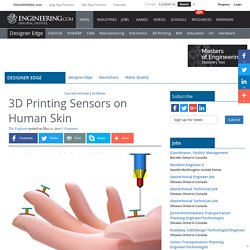
(Image courtesy of Shuang-Zhuang Guo/Michael McAlpine/University of Minnesota.) Engineering researchers at the University of Minnesota have developed a revolutionary process for 3D printing stretchable electronic sensory devices that could give robots the ability to feel their environment. The discovery is also a major step forward in printing electronics on real human skin. The research will be published in Advanced Materials and is currently online. "This stretchable electronic fabric we developed has many practical uses," said Michael McAlpine, a University of Minnesota mechanical engineering associate professor and lead researcher on the study.
McAlpine, who gained international acclaim in 2013 for integrating electronics and novel 3D-printed nanomaterials to create a "bionic ear," says this new discovery could also be used to print electronics on real human skin. The wrong neural path? How our understanding of the brain could be wrong. Understanding the human brain is arguably the greatest challenge of modern science.

The leading approach for most of the past 200 years has been to link its functions to different brain regions or even individual neurons (brain cells). But recent research increasingly suggests that we may be taking completely the wrong path if we are to ever understand the human mind. The idea that the brain is made up of numerous regions that perform specific tasks is known as “modularity”. And, at first glance, it has been successful. For example, it can provide an explanation for how we recognise faces by activating a chain of specific brain regions in the occipital and temporal lobes. Jack Ma: Las computadoras no se enojan, se acuerdan de todo, no descansan... se van a quedar con muchos empleos. El fundador del gigante del comercio electrónico chino Alibaba, Jack Ma, anunció en Buenos Aires que promoverá la comercialización de vinos, langostinos, pescados, carnes y pollos de empresas argentinas a compradores chinos.
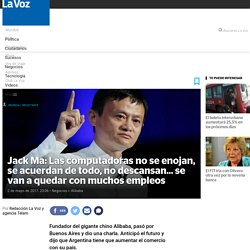
El chino destacó, en su exposición, que la inteligencia artificial cambiarán el panorama laboral en los próximos años. "Las computadoras no se enojan, se acuerdan de todo, no descansan. Fotorrelato: En estos colegios y universidades te encantaría estudiar. The robots shouldn't be stopped, but we need to keep things fair. BERKELEY – Former US Treasury Secretary Larry Summers recently took exception to current US Treasury Secretary Steve Mnuchin’s views on “artificial intelligence” (AI) and related topics.
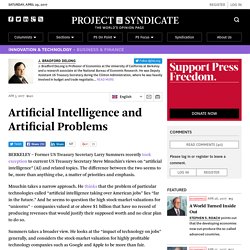
The difference between the two seems to be, more than anything else, a matter of priorities and emphasis. Mnuchin takes a narrow approach. He thinks that the problem of particular technologies called “artificial intelligence taking over American jobs” lies “far in the future.” And he seems to question the high stock-market valuations for “unicorns” – companies valued at or above $1 billion that have no record of producing revenues that would justify their supposed worth and no clear plan to do so. Summers takes a broader view. I think that Summers is right about the optics of Mnuchin’s statements. On the other hand, I sympathize with Mnuchin’s effort to warn non-experts against routinely investing in castles in the sky. Deep Learning in 7 lines of code – Chatbot’s Life. The essence of machine learning is recognizing patterns within data.
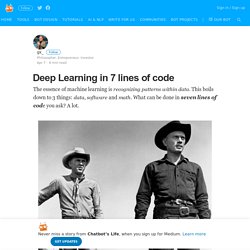
This boils down to 3 things: data, software and math. What can be done in seven lines of code you ask? A lot. The way to reduce a deep learning problem to a few lines of code is to use layers of abstraction, otherwise known as ‘frameworks’. Today we’ll use tensorflow and tflearn. Abstraction is an essential property of software: the app you are using to view this piece is an abstraction layer above some operating system that knows how to read files, display images, etc. and this is an abstraction above lower level functions. Software frameworks are abstraction layers. Our reduction is achieved by using tflearn, a layer above tensorflow, a layer above a Python. Let’s start at the beginning. El mito del desempleo tecnológico Por Pablo Maas. Kevin Kelly and Steven Johnson on Where Ideas Come From. Say the word “inventor” and most people think of a solitary genius toiling in a basement.
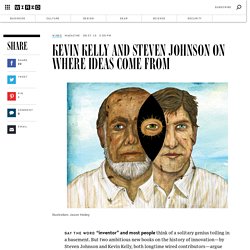
But two ambitious new books on the history of innovation—by Steven Johnson and Kevin Kelly, both longtime wired contributors—argue that great discoveries typically spring not from individual minds but from the hive mind. In Where Good Ideas Come From: The Natural History of Innovation, Johnson draws on seven centuries of scientific and technological progress, from Gutenberg to GPS, to show what sorts of environments nurture ingenuity. He finds that great creative milieus, whether MIT or Los Alamos, New York City or the World Wide Web, are like coral reefs—teeming, diverse colonies of creators who interact with and influence one another.
Seven centuries are an eyeblink in the scope of Kelly’s book, What Technology Wants, which looks back over some 50,000 years of history and peers nearly that far into the future. Kevin Kelly: Our books are another case in point. Johnson: Exactly. Kelly: Right. Mergeflow. The kimono blog - Create APIs, scrape the web, access data at scale. Becoming a Data Scientist - Curriculum via Metromap - Pragmatic Perspectives. Data Science, Machine Learning, Big Data Analytics, Cognitive Computing …. well all of us have been avalanched with articles, skills demand info graph’s and point of views on these topics (yawn!).

One thing is for sure; you cannot become a data scientist overnight. La innovación en 2015. El diccionario define “innovación” como “una novedad que se introduce en algo”.
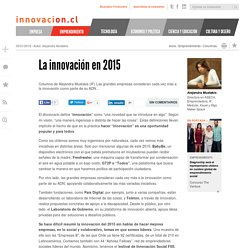
Según mi visión, “una manera ingeniosa o distinta de hacer las cosas”. Estas definiciones llevan implícito el hecho de que en la práctica hacer “innovación” es una oportunidad popular y para todos. Como los chilenos somos muy ingeniosos por naturaleza, cada vez vemos más iniciativas en distintas áreas. Solo por mencionar algunas de este 2015: BabyBe, un dispositivo electrónico con el que bebés prematuros en incubadoras pueden recibir señales de la madre; Freshwater, una máquina capaz de transformar por condensación el aire en agua potable a un bajo costo; GT2P o “Todos”, una plataforma que busca cambiar la manera en que hacemos política de participación ciudadana. Por otro lado, las grandes empresas consideran cada vez más a la innovación como parte de su ADN, apoyando colaborativamente las más variadas iniciativas. ENISA. Impulso financiero a la pyme.
Publicaciones. El Estado de la Ciencia 2015 La edición 2015 de El Estado de la Ciencia es una publicación que brinda los indicadores comparativos que recopila la RICYT, así como una serie de artículos específicos sobre temas actuales en materia de ciencia, tecnología.

En esta oportunidad, con motivo del vigésimo aniversario dela red, la publicación cuenta con un apartado especial conmemorando el surgimiento de la RICYT, su historia y desafíos futuros. Guías, indicadores y otros enlaces.